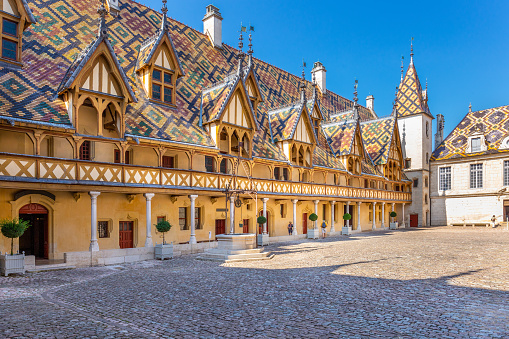"Wine is the intellectual part of the meal." Alexander Dumas
In the last edition of this blog I wrote about comprehending Chablis, a Chardonnay made in a part of Burgundy separated by 60 miles from the main part of Burgundy in the Cote de Beaune, which is also known for Chardonnay.
At the heart of Burgundy is the Cote d'Or, a narrow band of celebrated vineyards, running roughly from Dijon in the north to Chagny in the south, a distance of about 35 miles. The Cote d'Or (Golden Slope) is divided into the Cote d'Nuits, known for red wines made from Pinot Noir and the Cote de Beaune, famous both for Pinot Noirs and white wines made from Chardonnay.
The
city of Beaune is the capital of Burgundy, although the political
capital is in Dijon. It has been that way since the area was settled as
a Roman camp. A Beaune landmark is the Hospice de Beaune, a Middle Age charity hospital that serves today as the site for the famous auction of Burgundy wines, held annually at vintage.
The first merchant houses were founded in the 18th
century. Today, the names Bouchard, Jadot, Drouhin and Latour are
synonymous with great Burgundy.
 |
| Hospice de Beaune |
South of the city of Beaune, is where the Cote de Beaune really starts. First is Pommard, then Volnay and Monthelie. Three of the most vaunted names for white Burgundy -- Meursault, Puligny-Montrachet and Chassagne-Montrachet -- follow. Santaney is the most major southern wine town.
Digression --
Burgundians would think it strange to mention the grape in the region's
wines. Unlike California where it is common for wines to be labeled by
the grape name, most French wines (Alsace is an exemption) are
identified by a place name, such as the Cote de Beaune.
The nature of French wine making is to discuss the various component parts of a wine, of which the grape is but one component part of a specific terroir.
Puligny and Chassagne are two communes that wisely added the name of the most famous Chardonnay vineyard in the world, Le Montrachet, to the commune name: Puligny-Montrachet. The reputation of the coveted Le Montrachet is far greater than the size (20 acres) of the vineyard. Some observers maintain the Chardonnay rooted in limestone is key to the depth and complexity of Montrachet.
There are four other top-end Chardonnays with Montrachet attached to their names: Batard-Montrachet, Chevalier-Montrachet, Bienvenues-Batard-Montrachet and the rarely seen Criots-Batard-Montrachet.
Soil is an important factor in distinguishing the red wines of the Cote de Nuits and those of the Cote de Beaune. In general, soils in the north are richer, redder and with more iron, while those further south are lighter and with more sand than iron. This difference means that Cote de Beaune reds are medium in body and more likely to be at their peak in less than 10 years, while Cote de Nuits reds are richer, with more body, structure and aging potential.
There is a great deal of variation in the fermentation and aging of Cote de Beaune reds. Some producers prefer a long maceration with added stems, while others go for a shorter maceration with a little or no stems.
Resting the fermented wines in barrel for one year is the general rule, but the time in wood can be up to 18 months. There's also the type of oak to consider, plus the cooper and how much to toast the barrels. Finally, the question is to fine and filter or not. The main reason not to fine and filter is the belief that the practice reduces the flavor and aging potential of the wine.
| A typical Burgundy barrel cellar |
Digression -- Prior to bottling, a winemaker ponders whether or not to fine and filter the wine. Fining is a process aimed at clarifying the wine by using an agent such as egg whites or bentonite clay as a coagulant, causing microscopic particles to fall out of the wine, thus keeping it from turning hazy. Filtering is a process for removing solid particles, such as yeast cells, from a wine. Generally speaking, fining is gentler on a wine than filtering, making filtering a more controversial practice in the cellar.
Why am I going into wine making detail? Because when you're staring at a shelf lined with red Burgundies, it's important to know that stylistically, there are differences between a Clos de Vougeot (Cote de Nuits) and a Volnay Callerets (Cote de Beaune). Vougeot is dense and robust when young, but with bottle age, develops a refined earthiness. On the other hand, Volnay is lighter with less finesse, becoming fruitier and more robust with age.
Prices for Cote de Beaune wines vary widely. At the low end there's a standard Santaney, $30, while a Clos de Cortons Grand Cru will cost you $230. Other prices: Beaune 1er Cru, $38 to $50; Pommard 1er Cru, $190; Savigny-les-Beaune 1er Cru, $40 to $60, Clos Vougeot, $480.
What foods to serve with Cote de Beaune Burgundy is always a matter of personal taste. The classic match with red Burgundy is game birds. A more practical choice might be a lightly seasoned beef stew made with the same wine. With white Burgundy, the classic match is fish or a lightly sauced chicken. Whatever your choice, save your best bottle for the table and use a lesser wine for the recipe, such as a Volnay or Cote de Beaune, rather than the Volnay Callerets.
Sante!
Next blog: My Life in Wine Episode 14
Contact me at boydvino707@gmail.com
No comments:
Post a Comment
Note: Only a member of this blog may post a comment.